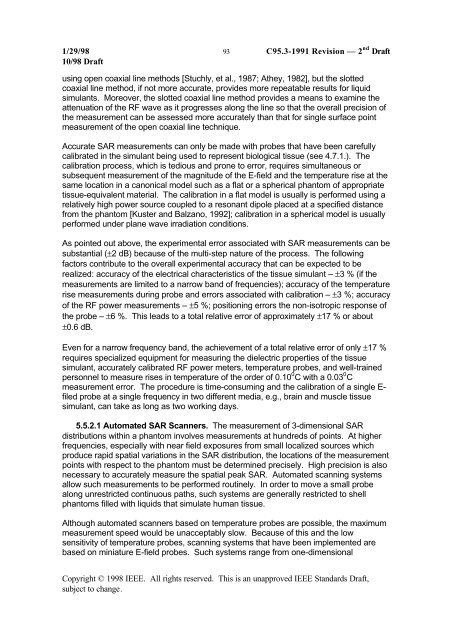DRAFT Recommended Practice for Measurements and ...
DRAFT Recommended Practice for Measurements and ...
DRAFT Recommended Practice for Measurements and ...
You also want an ePaper? Increase the reach of your titles
YUMPU automatically turns print PDFs into web optimized ePapers that Google loves.
1/29/98 93 C95.3-1991 Revision — 2 nd Draft<br />
10/98 Draft<br />
using open coaxial line methods [Stuchly, et al., 1987; Athey, 1982], but the slotted<br />
coaxial line method, if not more accurate, provides more repeatable results <strong>for</strong> liquid<br />
simulants. Moreover, the slotted coaxial line method provides a means to examine the<br />
attenuation of the RF wave as it progresses along the line so that the overall precision of<br />
the measurement can be assessed more accurately than that <strong>for</strong> single surface point<br />
measurement of the open coaxial line technique.<br />
Accurate SAR measurements can only be made with probes that have been carefully<br />
calibrated in the simulant being used to represent biological tissue (see 4.7.1.). The<br />
calibration process, which is tedious <strong>and</strong> prone to error, requires simultaneous or<br />
subsequent measurement of the magnitude of the E-field <strong>and</strong> the temperature rise at the<br />
same location in a canonical model such as a flat or a spherical phantom of appropriate<br />
tissue-equivalent material. The calibration in a flat model is usually is per<strong>for</strong>med using a<br />
relatively high power source coupled to a resonant dipole placed at a specified distance<br />
from the phantom [Kuster <strong>and</strong> Balzano, 1992]; calibration in a spherical model is usually<br />
per<strong>for</strong>med under plane wave irradiation conditions.<br />
As pointed out above, the experimental error associated with SAR measurements can be<br />
substantial (±2 dB) because of the multi-step nature of the process. The following<br />
factors contribute to the overall experimental accuracy that can be expected to be<br />
realized: accuracy of the electrical characteristics of the tissue simulant – ±3 % (if the<br />
measurements are limited to a narrow b<strong>and</strong> of frequencies); accuracy of the temperature<br />
rise measurements during probe <strong>and</strong> errors associated with calibration – ±3 %; accuracy<br />
of the RF power measurements – ±5 %; positioning errors the non-isotropic response of<br />
the probe – ±6 %. This leads to a total relative error of approximately ±17 % or about<br />
±0.6 dB.<br />
Even <strong>for</strong> a narrow frequency b<strong>and</strong>, the achievement of a total relative error of only ±17 %<br />
requires specialized equipment <strong>for</strong> measuring the dielectric properties of the tissue<br />
simulant, accurately calibrated RF power meters, temperature probes, <strong>and</strong> well-trained<br />
personnel to measure rises in temperature of the order of 0.10 0 C with a 0.03 0 C<br />
measurement error. The procedure is time-consuming <strong>and</strong> the calibration of a single E-<br />
filed probe at a single frequency in two different media, e.g., brain <strong>and</strong> muscle tissue<br />
simulant, can take as long as two working days.<br />
5.5.2.1 Automated SAR Scanners. The measurement of 3-dimensional SAR<br />
distributions within a phantom involves measurements at hundreds of points. At higher<br />
frequencies, especially with near field exposures from small localized sources which<br />
produce rapid spatial variations in the SAR distribution, the locations of the measurement<br />
points with respect to the phantom must be determined precisely. High precision is also<br />
necessary to accurately measure the spatial peak SAR. Automated scanning systems<br />
allow such measurements to be per<strong>for</strong>med routinely. In order to move a small probe<br />
along unrestricted continuous paths, such systems are generally restricted to shell<br />
phantoms filled with liquids that simulate human tissue.<br />
Although automated scanners based on temperature probes are possible, the maximum<br />
measurement speed would be unacceptably slow. Because of this <strong>and</strong> the low<br />
sensitivity of temperature probes, scanning systems that have been implemented are<br />
based on miniature E-field probes. Such systems range from one-dimensional<br />
Copyright © 1998 IEEE. All rights reserved. This is an unapproved IEEE St<strong>and</strong>ards Draft,<br />
subject to change.
















